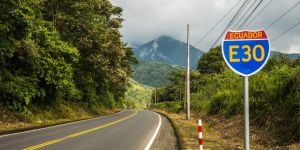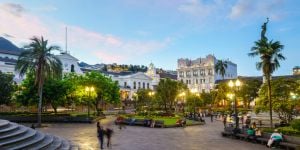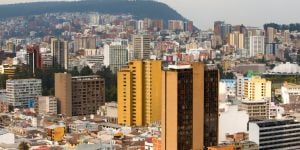Coming from Quito, I crossed into Colombia via the popular ‘Rumichaca’ route -- between Tulcán, Ecuador, and Ipiales, Colombia -- today.
I parked my car just across the line into Colombia and then walked to each of the governmental offices mentioned below.
Here are the Top Ten things I noticed or learned....
10. The Ecuador border agent told me that the border is open both ways 24 hours daily. This contradicts information posted around the Internet that the border closes at 9 p.m. Note that insurance sales and government offices at the border may or may not be open ‘after hours.’ When I crossed in mid-afternoon, nobody was stopping vehicles entering Colombia there.
9. Required car insurance going into Colombia is cheap. I paid less than $12 U.S. (in pesos) for a month’s ‘SOAT’ coverage.
8. First stop heading into Colombia is the Ecuador Inmigración office. Park and show passport. Cost for my salida to leave Ecuador: nada. Time on line: five minutes.
7, You need this salida or exit pass to show at Colombia Inmigración. There you may request up to 90 days on your tourist stamp issued by this agency. Cost for 90 days’ stamp: nada. Time on line: 30 minutes.
6. The COL agent told me that later on I could get an extension to stay in Colombia for an additional 90 days at any Inmigración office inside Colombia. 180 consecutive days in Colombia is the maximum for tourist stamp and extension.
5. The same agent told me that this extension is available all at once, not monthly installments of 30 days. This contradicts information posted around the Internet.
4. Next stop: Colombia’s DIAN agency to get approval to ‘import' a car into Colombia. The agent required copies of my Ecuadorian ID, my US passport and my registration or matriculación for my Ecuadorian car. She inspected the originals as well.
3. The DIAN agent politely asked if she could take picture(s) of my car (as if I had a choice). Por supuesto, says I. (Translation: of course.)
2. At the vehicle, she had me open the hood and she photographed the VIN plate that is located under the hood. This is the permanent VIN (vehicle ID number) location, as opposed to the sticker showing the VIN on my windshield. By this point, I had already received the paperwork approving the ‘import’ of my car into Colombia. Cost to bring the car into Colombia: nada.
And the Number One thing I learned about bringing a car into Colombia....
1. The DIAN agent didn’t seem to care whether I had the car inspected (the revisión) in Ecuador at any time in the recent past. As long as the documents mentioned above were still valid, I was good to go.
cccmedia from near the Tulcán, Ecuador - Ipiales, Colombia border crossing
FYI: I still do not understand the Ecuadorian revisión rules, or whether my car -- being less than one year old -- needed to undergo this inspection to be completely legal in Ecuador.... Also, the usual caveat applies: All rules are subject to change or re-interpretation at the whim of governmental agencies or border agents .. or due to changes in the rules.
 Driving in Ecuador
Driving in Ecuador Food in Ecuador
Food in Ecuador Work in Ecuador
Work in Ecuador Family and children in Ecuador
Family and children in Ecuador Opening a bank account in Ecuador
Opening a bank account in Ecuador Healthcare in Ecuador
Healthcare in Ecuador The Working Holiday Visa for Ecuador
The Working Holiday Visa for Ecuador Leisure activities in Ecuador
Leisure activities in Ecuador


